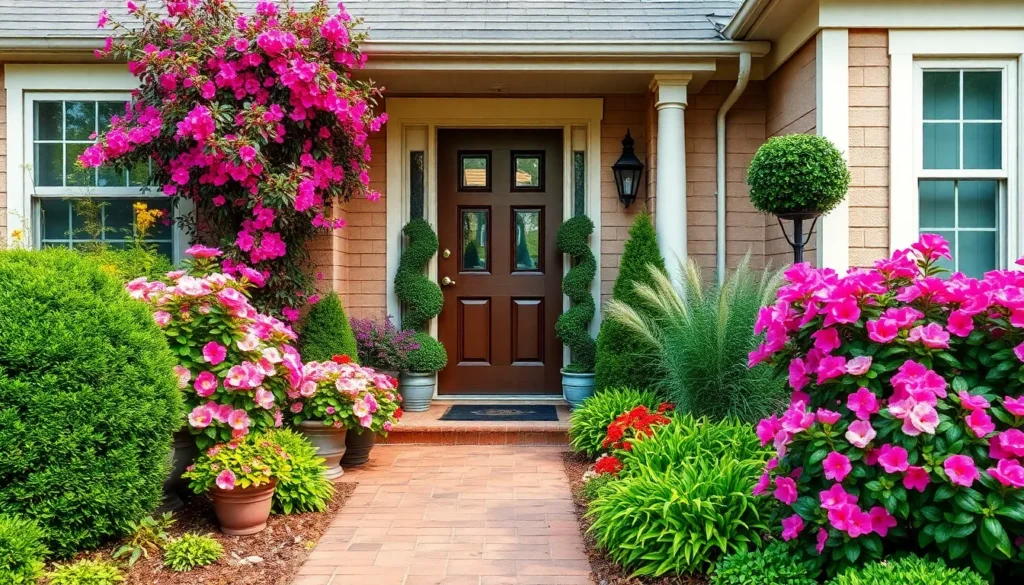Your front door entrance sets the tone for your entire home and selecting the right plants can transform this space from ordinary to extraordinary. We’ve all walked past homes that make us pause and admire their stunning curb appeal – and strategic plant placement at the entrance plays a crucial role in creating that wow factor.
Whether you’re working with a grand porch a narrow stoop or a simple doorway we’ll help you discover the perfect plants that thrive in your exact conditions. From low-maintenance succulents to dramatic statement plants there’s an ideal option for every style preference and gardening skill level.
Creating an inviting entrance doesn’t require a massive budget or extensive gardening experience. With the right plant choices you’ll boost your home’s value while creating a welcoming atmosphere that guests will remember long after they leave.
Choose Low-Maintenance Evergreen Shrubs for Year-Round Appeal
Evergreen shrubs deliver consistent visual impact throughout all seasons while requiring minimal upkeep. We’ll explore three exceptional options that thrive near front door entrances.
Boxwood for Classic Elegance
Boxwood creates timeless sophistication that complements traditional and contemporary home styles alike. These dense shrubs maintain their rich green foliage year round, making them perfect foundation plants for entrance areas.
Common varieties include English boxwood (Buxus sempervirens) and Japanese boxwood (Buxus microphylla). Both species tolerate pruning exceptionally well, allowing you to shape them into formal hedges, topiaries, or natural rounded forms.
Maintenance requirements stay remarkably simple with boxwood plantings. Water deeply once or twice weekly during dry periods, and apply a balanced fertilizer in early spring. Pruning becomes necessary only twice per year to maintain desired shapes.
Growth patterns remain predictably slow, reaching 3 to 6 feet at maturity depending on the variety. This controlled growth means less frequent trimming and better long term planning for your entrance design.
Juniper for Modern Landscapes
Juniper varieties offer striking architectural presence that enhances contemporary front door designs. These hardy evergreens adapt to various soil conditions and climate zones while providing unique textures and forms.
Popular entrance options include upright junipers like Juniperus scopulorum ‘Skyrocket’ and spreading varieties such as Juniperus horizontalis ‘Blue Rug’. Each type brings distinct visual characteristics to modern industry schemes.
Drought tolerance makes junipers exceptionally practical for busy homeowners seeking beautiful yet sustainable plantings. Once established, these shrubs survive extended dry periods without supplemental watering in most regions.
Pruning needs remain minimal throughout the growing season. Remove dead or damaged branches as needed, and lightly shape plants in late winter to maintain desired forms without encouraging excessive new growth.
Holly for Seasonal Interest
Holly shrubs provide ever-changing visual appeal through their glossy evergreen leaves and vibrant winter berries. These versatile plants create stunning focal points while supporting local wildlife throughout colder months.
American holly (Ilex opaca) and Japanese holly (Ilex crenata) represent excellent choices for entrance plantings. Female plants produce the decorative berries when male plants grow nearby for pollination.
Berry production peaks during winter months, offering natural holiday decorations right outside your front door. Red, orange, or yellow berries create striking contrasts against dark green foliage and snowy backgrounds.
Care requirements stay straightforward for established holly plants. Provide consistent moisture during the first growing season, then reduce watering frequency as root systems mature. Annual pruning in late winter maintains shape while encouraging healthy new growth.
Select Colorful Flowering Plants to Create Welcoming Curb Appeal
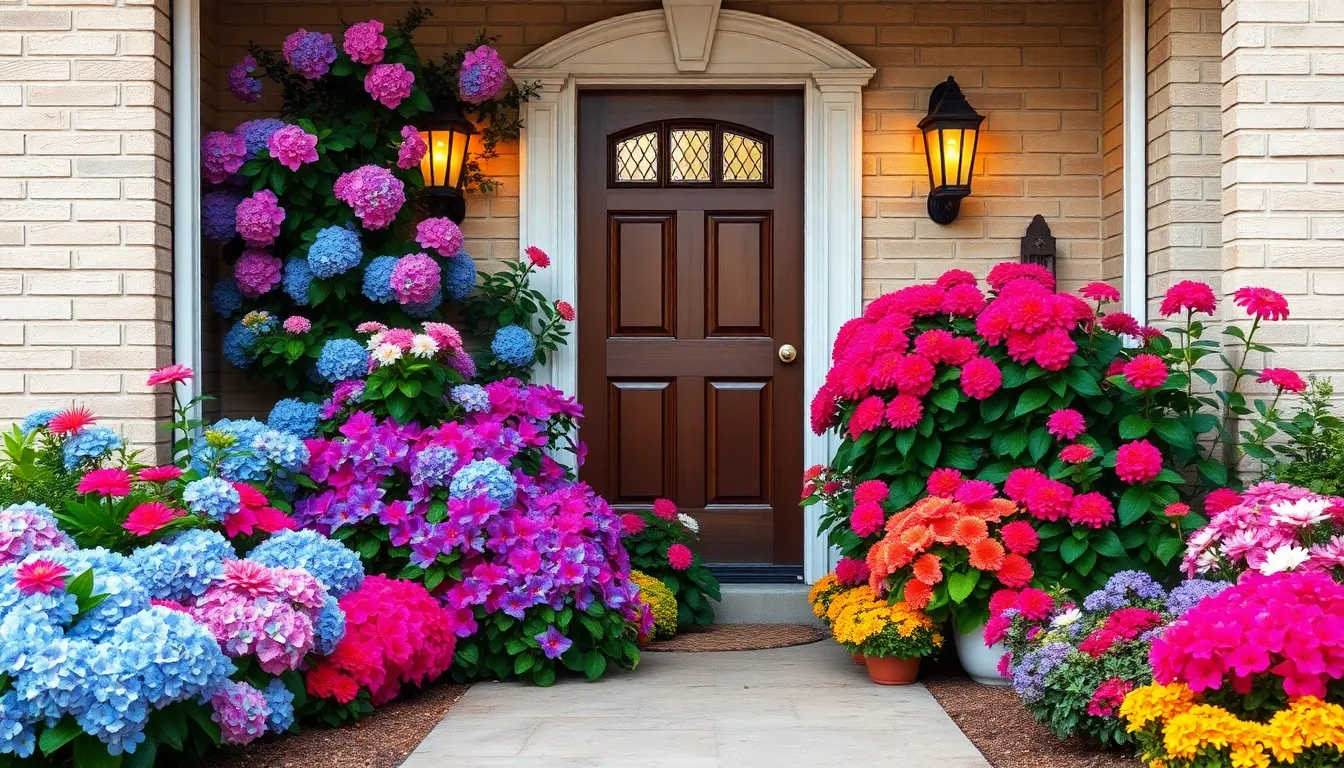
Moving beyond evergreens, we can transform our front entrance into a vibrant seasonal showcase with carefully chosen flowering plants that provide continuous color throughout the year.
Hydrangeas for Summer Blooms
Hydrangeas deliver spectacular summer displays with their large, lush flower clusters that create an instantly welcoming atmosphere. These voluminous blossoms offer a soft, elegant look that perfectly frames doorways during the warmest months of the year.
We love how hydrangeas provide that coveted cottage garden charm while requiring minimal maintenance once established. Their impressive size and abundant blooms make a bold statement that draws the eye and creates a focal point for our entrance design. Summer visitors will appreciate the cooling visual effect these substantial flowers provide during hot weather.
Azaleas for Spring Color
Azaleas bring the first burst of vibrant color to our front door entrance each spring with their bright, bold blooms. These early flowering shrubs offer cheerful energy that signals winter’s end and creates an enthusiastic welcome for guests.
Spring’s arrival becomes unmistakable when azaleas burst into bloom with their eye catching display of vivid flowers. We appreciate how these reliable performers provide that essential pop of color just when our outdoor spaces need it most. Their compact growth habit makes them perfect for flanking doorways without overwhelming smaller entrance areas.
Chrysanthemums for Fall Display
Chrysanthemums extend our seasonal color palette into autumn with rich warm tones including gold, red, and orange that perfectly complement fall decor. These late season bloomers ensure our entrance maintains visual interest even as other plants begin their dormant phase.
Fall’s beauty gets enhanced when we incorporate chrysanthemums that bloom precisely when we need that final seasonal flourish. We find their diverse color options allow us to coordinate with existing autumn decorations like pumpkins and seasonal wreaths. Their timing couldn’t be better since they provide fresh flowers just as we’re preparing for holiday entertaining and want our homes to look their absolute best.
Consider Container-Friendly Options for Flexible Design
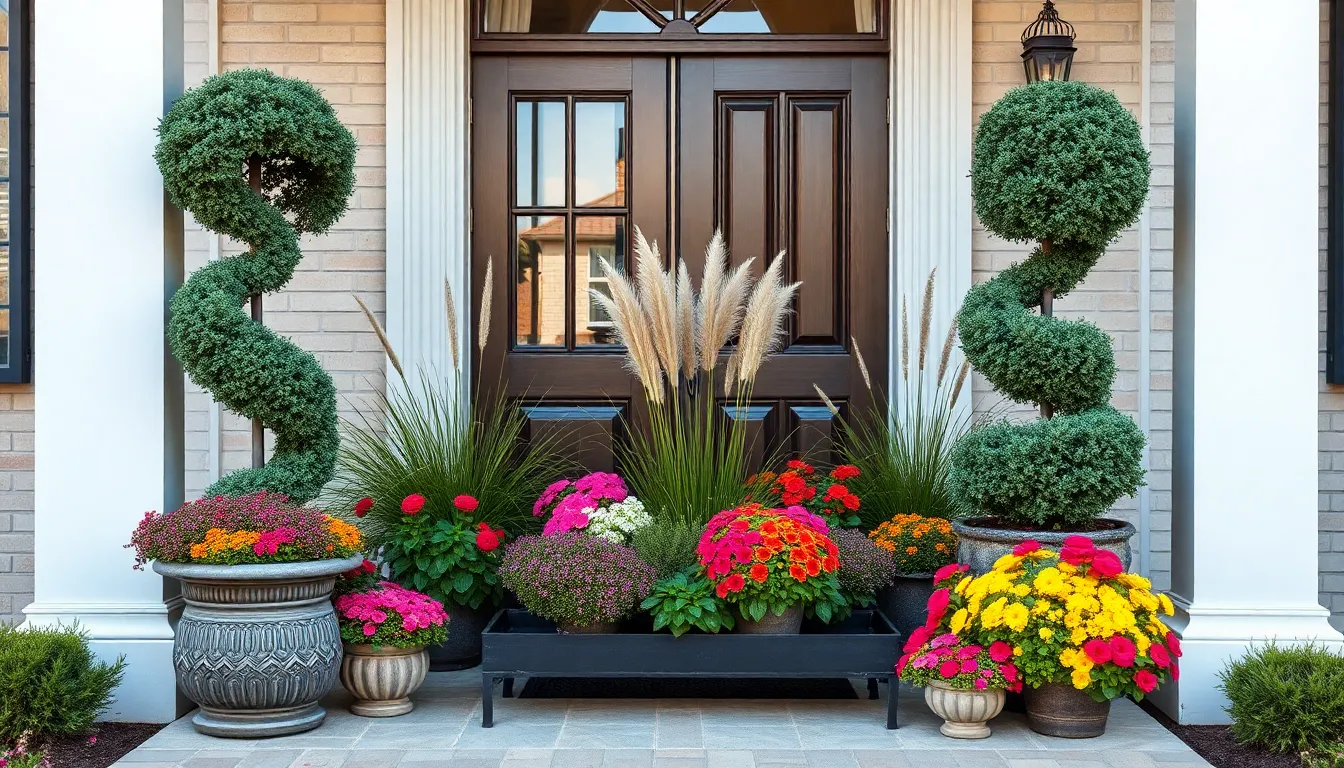
Container gardening provides exceptional adaptability for your front door entrance design. We can easily move and change plants seasonally or to suit your evolving style preferences.
Topiary Trees for Formal Entrance
Topiaries create a classic, polished look that instantly elevates your entrance’s sophistication. Small thyme topiaries offer an herbaceous scent and culinary use without taking up much space around your doorway. Larger topiary trees can frame the door symmetrically to add structure and architectural interest.
Popular container topiary options include:
- Boxwood spheres for timeless elegance
- Rosemary spirals for aromatic appeal
- Bay laurel standards for Mediterranean charm
Ornamental Grasses for Texture
Ornamental grasses add natural texture and graceful movement to your entrance design. Mixed with other plants, grasses soften the harsh architectural lines of your doorway and create visual balance. Container grown grasses like fountain grass or Japanese forest grass complement flowering plants beautifully.
Benefits of ornamental grasses:
- Provide year round structural interest
- Require minimal maintenance once established
- Add height variation to your plant arrangements
Seasonal Annuals for Color Rotation
Annuals offer vibrant color changes throughout the year for ever-changing entrance appeal. Begonias bloom profusely in hot pink and come back perennially in warm climates, making them perfect for shaded entrances. Purple coneflowers add a bright pop of fuchsia that attracts pollinators and thrives in many zones.
Hydrangeas provide show stopping large blooms and work exceptionally well in containers with morning sun and afternoon shade. Their colors add seasonal interest year to year, transforming from spring greens to summer blues and fall burgundies.
- Spring: Pansies and primrose for cool weather color
- Summer: Impatiens and coleus for heat tolerance
- Fall: Mums and ornamental kale for autumn warmth
Pick Weather-Resistant Plants That Thrive in Your Climate Zone

Selecting plants that naturally thrive in your exact climate zone ensures your front door entrance remains stunning year round with minimal maintenance. We’ll explore the best plant options for three distinct climate conditions to help you create a resilient and beautiful entrance.
Drought-Tolerant Succulents for Dry Regions
Cacti varieties make exceptional front door plants for hot, sunny climates due to their extremely low watering requirements. The Peruvian Apple Cactus stands out as a striking choice that adds architectural interest while requiring minimal care. These plants demand well-draining soil to prevent root rot, making them perfect for homeowners in arid regions.
Succulent collections offer incredible diversity in shapes, colors, and textures for dry climate entrances. Jade plants, echeveria, and agave varieties create stunning displays that require watering only once or twice per month. Their fleshy leaves store water efficiently, allowing them to thrive during extended dry periods without compromising their visual appeal.
Maintenance benefits of drought tolerant plants include reduced water bills and less frequent care requirements. We recommend grouping different succulent varieties in attractive containers to create visual interest while maintaining the low maintenance appeal that makes these plants ideal for busy homeowners.
Cold-Hardy Perennials for Northern Areas
Hydrangeas deliver spectacular blooms year after year, making them perfect perennial investments for northern front door entrances. These plants require morning sun and consistent moisture but reward gardeners with massive flower clusters in pink, blue, or white. Their ability to return annually provides reliable beauty without replanting costs.
Begonia varieties offer vibrant colors and thrive in shaded entrance areas where other flowering plants struggle. Hardy begonia types can overwinter outdoors in warmer northern zones, providing continuous blooms throughout the growing season. Regular deadheading keeps these plants looking fresh and encourages more flower production.
Perennial advantages include cost savings over time since these plants return each spring without replacement. Northern gardeners benefit from choosing plants rated for their exact USDA hardiness zone to ensure survival through harsh winter conditions.
Heat-Loving Tropicals for Southern Climates
Hawaiian Dwarf Umbrella Trees thrive in high sun conditions and make stunning statement plants for wide southern porches. These tropical beauties prefer occasional deep watering rather than frequent light watering, making them surprisingly low maintenance. Their glossy leaves and upright growth habit create an elegant tropical ambiance.
Dwarf Gardenias perform best in USDA zones 7-10, offering intensely fragrant white blooms that perfume your entire entrance area. These compact shrubs fit perfectly in small spaces while delivering the classic Southern charm that homeowners love. Their evergreen nature provides year round structure even when not in bloom.
Tropical plant benefits include extended growing seasons and the ability to create resort like atmospheres at home entrances. Southern gardeners can choose from a wider variety of exotic plants that would require special care or indoor wintering in colder climates.
Arrange Plants by Height to Create Visual Balance at Your Entrance
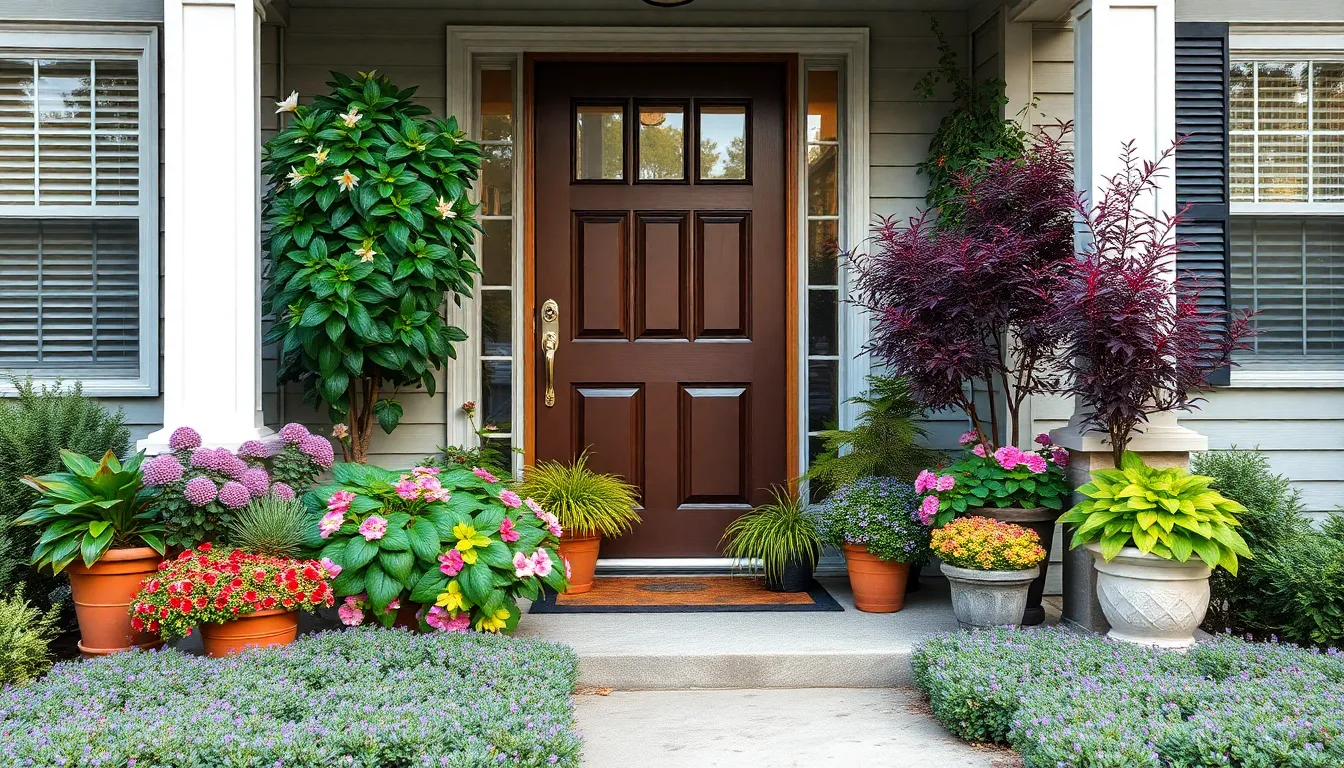
Creating a layered design with plants of varying heights transforms your entrance into a professionally designed space that naturally guides the eye toward your front door.
Tall Statement Plants as Focal Points
Tall plants serve as visual anchors that establish the foundation of your entrance design. Position these statement pieces at the back or sides of your arrangement to create maximum impact without blocking the doorway.
Potted star jasmine makes an excellent choice for its elegant growth pattern and fragrant blooms that welcome guests with natural aromatics. Japanese maple trees offer stunning seasonal color changes, and you can choose real specimens for authentic beauty or high-quality faux versions for zero maintenance requirements.
Hydrangeas in large containers deliver spectacular results with their oversized, colorful blooms that create instant curb appeal. Place them in morning sun with afternoon shade locations, and maintain consistent moisture levels to ensure vigorous flowering throughout the growing season.
Tall topiaries like thyme varieties provide sculptural elements that add architectural interest to your entrance design. These living sculptures require minimal care while offering the bonus of harvestable herbs for your kitchen.
Medium-Height Filler Plants for Depth
Medium-height plants bridge the gap between your tall focal points and ground covers, creating essential depth and visual texture in your layered arrangement.
Purple coneflowers bring vibrant color while attracting beneficial pollinators to your entrance garden. These hardy perennials return year after year in most growing zones, making them cost-effective additions that provide reliable seasonal interest.
Begonias excel in shaded entrance areas where they produce vivid colors and bloom continuously throughout the growing season. Deadhead spent flowers regularly to encourage prolific blooming and maintain their neat appearance.
English ivy works beautifully as trailing or climbing medium-height coverage that can frame doorways and soften harsh architectural lines. This versatile plant adapts to various light conditions and provides year-round greenery.
Ground Cover Plants for Finishing Touches
Low-growing plants complete your layered design by softening hard edges around pavement, steps, and container bases while adding final textural elements.
Thyme varieties offer dual functionality as both aromatic ground covers and harvestable herbs for cooking. Their pleasant fragrance releases when brushed against, creating a sensory welcome experience for visitors.
Trailing vines in containers or window boxes finish the industry with lush, cascading elements that add movement and softness to rigid entrance structures. Choose varieties that complement your exact sunlight exposure conditions for optimal growth and appearance.
Choose Fragrant Plants to Enhance the Sensory Experience
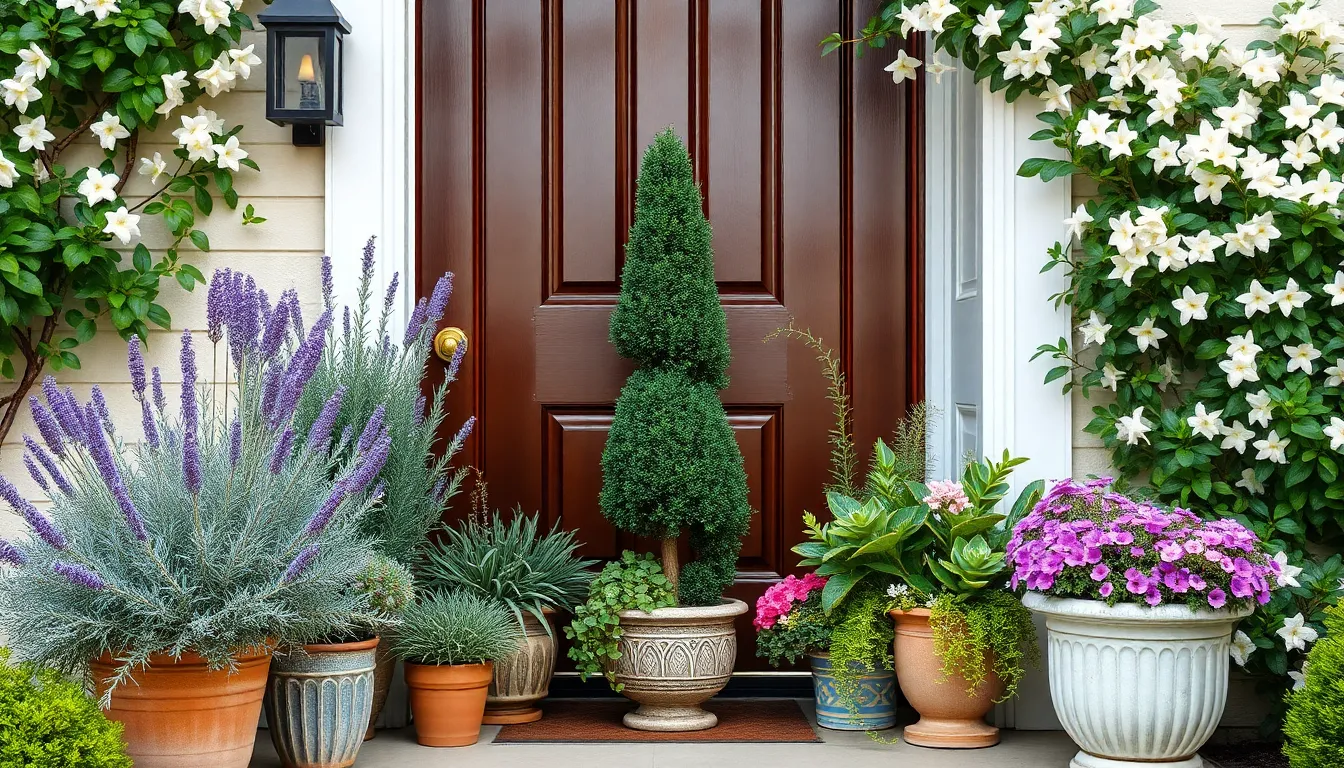
Scent creates an immediate emotional connection with your home, making fragrant plants essential for a truly welcoming entrance. We’ll explore the best aromatic options that greet guests with delightful fragrances while maintaining visual appeal.
Lavender for Calming Aromatherapy
Lavender transforms your doorway into a natural aromatherapy station with its soothing, stress-relieving scent. Vera English lavender stands out as the most fragrant variety, featuring beautiful silvery-green foliage that complements its therapeutic properties. Purple blooms appear in early summer, often producing a second wave of flowers in early fall when pruned correctly.
Full sun and well-draining soil create optimal growing conditions for lavender plants. Container growing works exceptionally well for front door placements, allowing you to position the fragrance exactly where guests will encounter it. Brushing against lavender releases its calming oils, creating an instant mood boost for anyone entering your home.
Rosemary for Herbal Fragrance
Rosemary delivers a fresh, Mediterranean scent that adds sophistication to your entrance design. This evergreen herb maintains its fragrance year-round, making it perfect for consistent aromatic impact. Shaping rosemary into neat topiaries or structured forms creates elegant focal points in doorway containers.
Mediterranean gardens inspire this herb’s natural growing style, thriving in sunny locations with minimal water requirements. Even light contact with rosemary branches releases its distinctive herbal aroma, making it ideal for narrow walkways where guests might brush against it. Culinary uses add practical value, allowing you to harvest fresh herbs while maintaining your entrance’s beauty.
Jasmine for Evening Scents
Jasmine creates enchanting evening atmospheres with its intensely sweet fragrance that peaks after sunset. Star jasmine and Carolina jasmine varieties produce small, trumpet-shaped flowers in white or yellow that perfume the air as temperatures cool. Climbing habits make jasmine perfect for framing doorways on trellises, arbors, or wall-mounted supports.
Evening entertaining becomes more magical when jasmine’s scent fills the air around your entrance. Pollinators like hummingbirds and butterflies find jasmine irresistible, adding ever-changing movement to your doorway throughout blooming seasons. Training jasmine vines requires minimal effort but creates maximum impact for both fragrance and visual drama.
| Fragrant Plant | Peak Scent Time | Growth Habit | Best Container Size |
|---|---|---|---|
| Vera English Lavender | All day, strongest in warm weather | Compact shrub | 12-16 inches wide |
| Rosemary | Consistent year-round | Upright herb | 10-14 inches wide |
| Star Jasmine | Evening hours | Climbing vine | 18-24 inches wide |
Select Plants That Complement Your Home’s Architectural Style
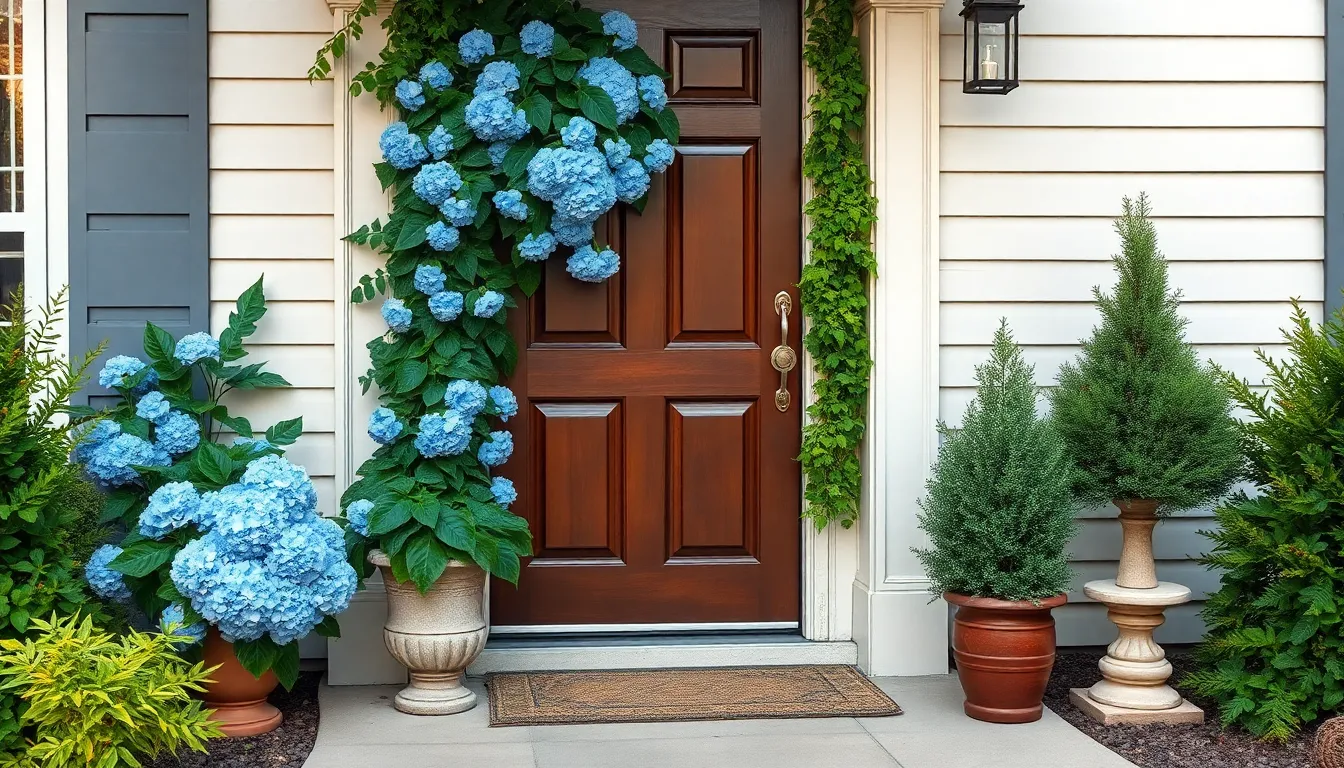
Matching plants to your home’s architectural style creates a cohesive design that enhances your property’s overall aesthetic appeal. We’ll explore exact plant selections that work best with different architectural styles to help you achieve the perfect front entrance.
Traditional Plants for Classic Homes
English Ivy stands out as the quintessential choice for classic homes, offering timeless elegance that frames doorways beautifully. This versatile vine can be easily trained to grow up walls or trellises, creating that coveted traditional look that never goes out of style. We recommend planting it in sturdy containers or allowing it to establish along architectural features for maximum impact.
Hydrangeas deliver spectacular seasonal drama with their large, showy blooms that perfectly complement traditional home styles. These reliable performers create a welcoming entrance throughout the growing season while requiring minimal maintenance once established. Their generous flower clusters in shades of blue, pink, and white provide the perfect backdrop for classic architectural elements like columns and porticos.
Contemporary Plants for Modern Architecture
Faux Mini Japanese Maple Trees offer sleek sophistication without the maintenance demands that busy homeowners often want to avoid. These artificial options provide clean lines and modern appeal while maintaining their perfect shape year round. We suggest placing them in minimalist planters that complement your home’s contemporary materials and color palette.
Potted Star Jasmine brings structured beauty to modern entrances with its glossy foliage and occasional fragrant blooms. This plant’s naturally tidy growth habit requires only minimal pruning to maintain its crisp, geometric appearance. Its compact size makes it ideal for flanking modern front doors or creating symmetrical displays that enhance clean architectural lines.
Cottage Garden Plants for Rustic Charm
Thyme Topiaries add delightful herbaceous fragrance while maintaining charming, cottage style appeal. These small-scale topiaries bring a homey, rustic feel to your entrance while offering the practical benefit of fresh herbs for cooking. We love how their delicate texture contrasts beautifully with rougher architectural materials like stone or weathered wood.
Purple Coneflower creates vibrant color displays that attract beneficial pollinators to your entrance area. This hardy perennial establishes easily and returns year after year with minimal care, making it perfect for cottage garden aesthetics. Its cheerful purple blooms provide excellent contrast against rustic home materials while supporting local wildlife throughout the growing season.
Plan for Proper Spacing and Growth Requirements
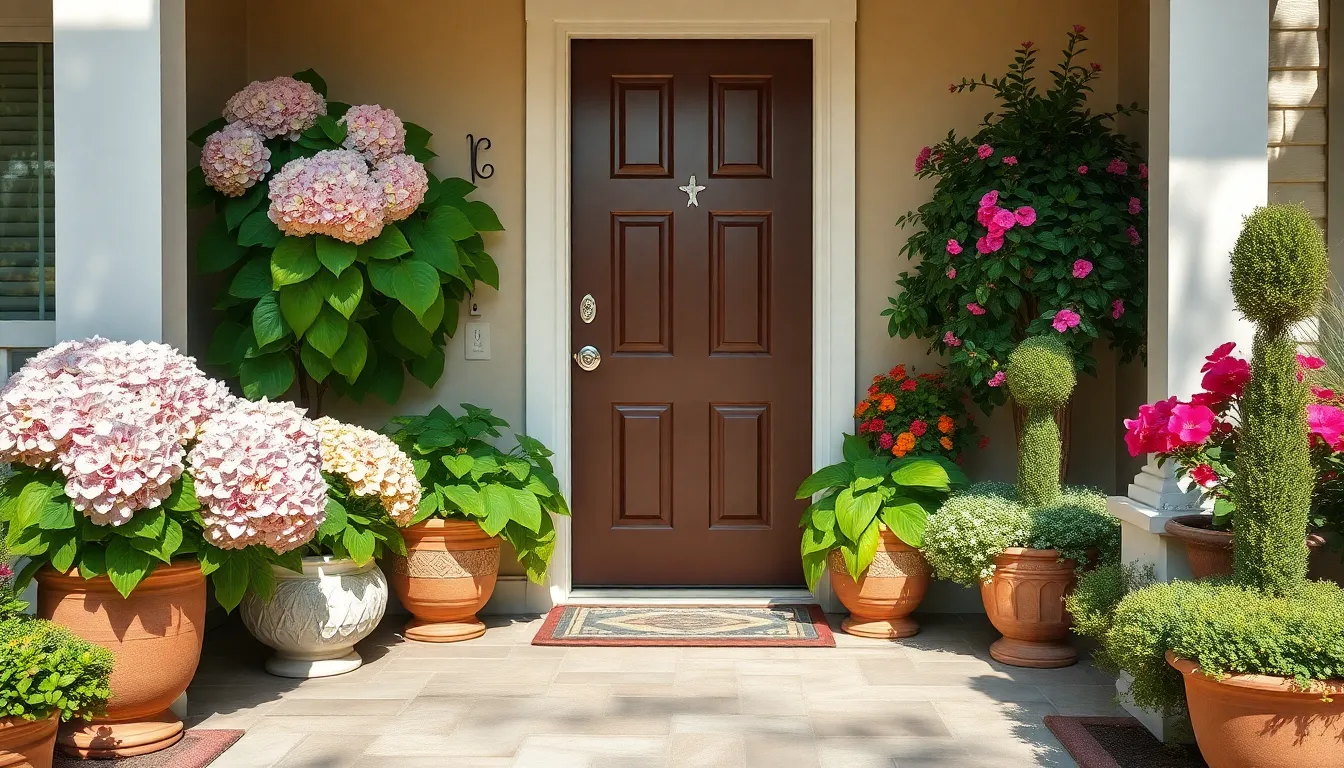
Strategic spacing prevents overcrowding and ensures your front door plants have room to flourish without blocking pathways or overwhelming the entrance.
Understanding Mature Plant Sizes
Researching the expected mature size of each plant helps us avoid costly mistakes and maintains a balanced, proportional look at our entrance. Showy hydrangeas can grow quite large with massive blooms, making them ideal in large containers flanking the door where they create an impressive focal point without overwhelming the space. Smaller sized plants like begonias work perfectly in shady entrances, maintaining vivid, colorful displays without excessive growth that could obstruct walkways.
Container gardening offers excellent size control, allowing us to choose appropriately sized pots that naturally limit plant growth. Thyme topiaries provide a compact, minimalistic option that doesn’t consume much space and can be easily maintained through simple pruning techniques. Faux plants like mini Japanese maples give us the desired aesthetic without any growth concerns or ongoing maintenance requirements.
Allowing for Root Development
Root space directly impacts plant health and longevity, especially for container plants at our entrance. Choosing appropriately sized pots ensures roots have adequate room to grow and access essential nutrients for sustained health. Vine plants like English ivy benefit from supporting structures or stands that help them grow upward or trail attractively without experiencing root crowding issues.
Proper container selection prevents root bound conditions that can stunt growth and reduce flowering potential. We should select pots that are at least 2 inches wider than the current root ball to allow for healthy expansion. Deep rooted plants require containers with sufficient depth to accommodate their natural growth patterns and prevent stress.
Considering Light and Water Needs
Matching plants to our front door’s exact exposure conditions ensures they’ll thrive with minimal intervention and maintenance. Hydrangeas perform best with morning sun followed by afternoon shade and require consistent watering to maintain their spectacular blooms throughout the growing season. Begonias bloom exceptionally well in shaded areas and need regular deadheading to prolong their flowering period and maintain visual appeal.
Star jasmine requires only occasional pruning but remains otherwise low maintenance with moderate water and light requirements, making it suitable for various porch conditions. We must assess whether our entrance receives full sun, partial shade, or full shade before selecting plants to ensure optimal growing conditions. Different plant combinations work best when they share similar water and light requirements, simplifying our maintenance routine while creating cohesive displays.
Conclusion
Creating a stunning front door entrance with the right plants transforms your home’s first impression while adding lasting value. We’ve explored diverse options from low-maintenance evergreens to vibrant seasonal bloomers that suit every climate and architectural style.
Whether you choose fragrant lavender for sensory appeal drought-tolerant succulents for easy care or elegant topiaries for sophistication the key lies in thoughtful selection and proper planning. Remember to consider your exact conditions including sunlight exposure climate zone and available space.
Your entrance garden doesn’t need to be complicated or expensive to make a important impact. With these plant recommendations and design principles you’re equipped to create an inviting welcoming space that reflects your home’s unique character and thrives throughout the seasons.
Frequently Asked Questions
What are the best low-maintenance plants for front door entrances?
Evergreen shrubs like boxwood, juniper, and holly are excellent choices for front entrances. Boxwood offers classic elegance with minimal upkeep, juniper provides modern aesthetics with drought tolerance, and holly adds seasonal interest with vibrant berries. These plants maintain year-round appeal and require simple maintenance, making them perfect for busy homeowners.
Which flowering plants work best for seasonal front door displays?
Hydrangeas provide spectacular summer blooms, azaleas offer bright spring flowers that signal winter’s end, and chrysanthemums deliver rich fall colors. These flowering plants create vibrant seasonal showcases while requiring minimal maintenance, ensuring your entrance remains welcoming and colorful throughout different seasons.
How can container gardening enhance my front entrance design?
Container gardening offers flexibility for seasonal changes and style adaptations. You can use topiary trees for sophistication, ornamental grasses for texture and movement, and seasonal annuals for vibrant color rotation. This approach allows easy plant swapping and provides excellent size control for your entrance design.
What plants work best in different climate zones?
For dry regions, choose drought-tolerant succulents like Peruvian Apple Cactus and jade plants. Northern areas benefit from cold-hardy perennials such as hydrangeas and begonias. Southern climates thrive with heat-loving tropical plants like Hawaiian Dwarf Umbrella Trees and Dwarf Gardenias for low-maintenance, resort-like atmospheres.
How should I arrange plants by height for visual balance?
Create visual balance using tall statement plants like potted star jasmine as focal points, medium-height filler plants such as purple coneflowers for depth, and ground cover plants like thyme for finishing touches. This layered approach ensures a comprehensive and visually appealing entrance design.
Which fragrant plants enhance the entrance experience?
Lavender offers calming aromas and container-friendly growth, rosemary provides fresh herbal scents with culinary benefits, and jasmine creates enchanting evening fragrances. These fragrant plants add sensory appeal beyond visual beauty, creating an inviting atmosphere that engages guests’ senses and enhances the overall entrance experience.
How do I match plants to my home’s architectural style?
Classic homes pair well with English Ivy and hydrangeas for timeless elegance. Modern homes benefit from faux Mini Japanese Maple Trees and potted Star Jasmine for sleek, low-maintenance appeal. Rustic cottage gardens thrive with thyme topiaries and purple coneflowers that attract pollinators and add natural charm.
What spacing considerations are important for front entrance plants?
Research plants’ expected mature sizes to prevent overcrowding and maintain balanced aesthetics. Use container gardening for size control, select appropriately sized pots for root development, and match plants to your entrance’s specific light and water conditions. Proper spacing ensures healthy growth and simplified maintenance.

